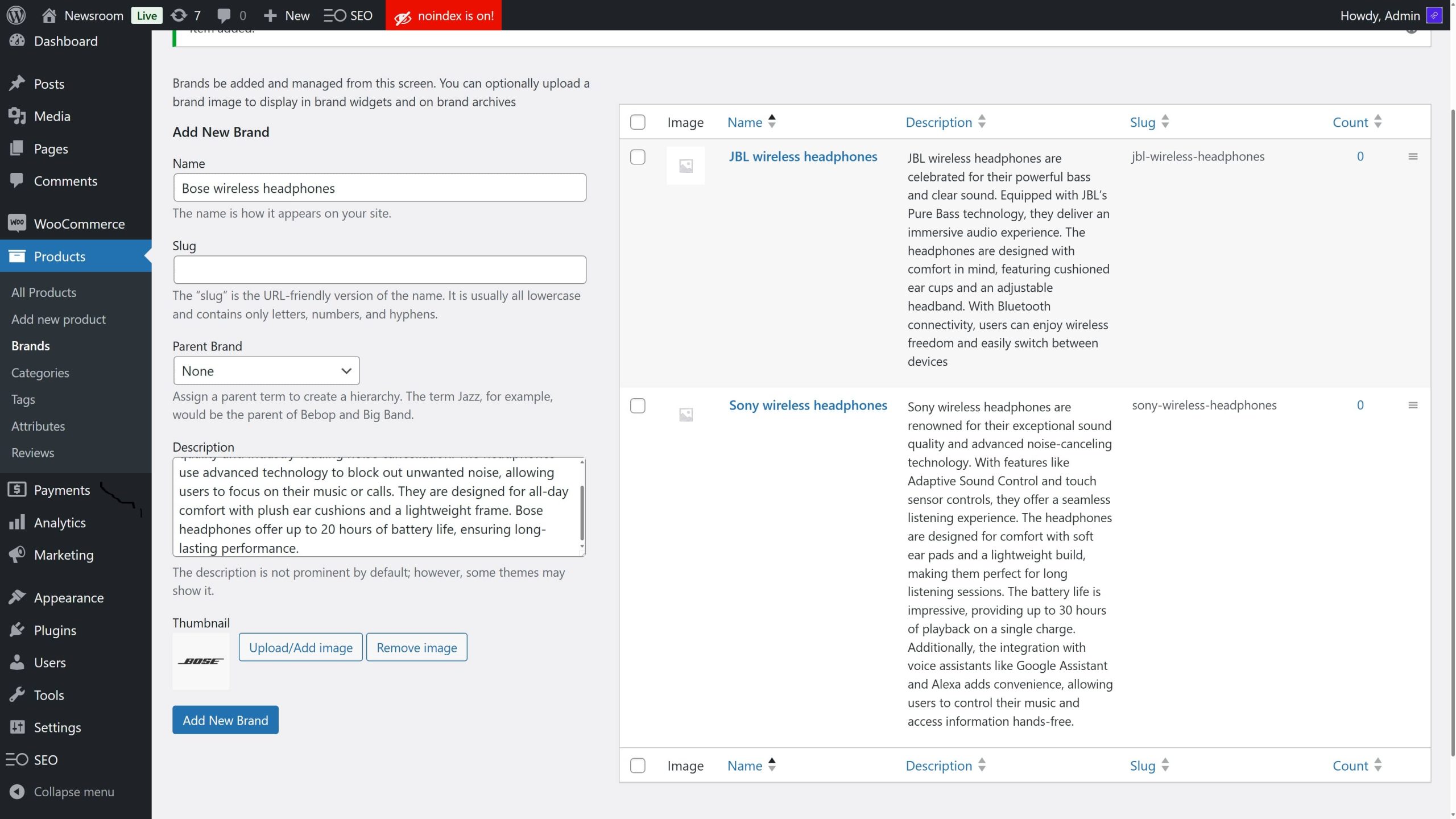We are considering eCommerce as a business whose main activity is selling online. Often these businesses do not have premises open to the public and may not even manage stock (drop-shipping or non-physical goods).
A successful SEO strategy must take into account the actual products on sale and product pages need to be optimized for Google with particular attention paid to the latest enriched search results for eCommerce.
To illustrate the method for creating an SEO strategy for eCommerce, we will take the example of an Australian online store selling wireless headphones.
Step 1: Install SEOPress
If you are serious about doing SEO for your eCommerce, you should install SEOPress. For the purposes of this guide, we will assume that you are using WordPress, WooCommerce and the latest version of the SEOPress PRO plugin. You will be particularly interested in the WooCommerce SEO features.
Choosing SEO Keywords for eCommerce
When working with an eCommerce that sells well-known brands, you will often find that the keywords chose you rather than you chose the keywords. Keywords will be dictated by the products in stock. In the case of electronic products like wireless headphones, customers know the brands and even the specific models and search for them on Google. Our keyword research for the Australian market for wireless headphones revealed the following results:

The information which will drive the strategy of this website:
- The volume of searches for specific brands and even specific models outweighs the volume of other searches
- Apart from “wireless headphones”, “Bluetooth headphones” and ‘wireless earbuds”, there are not many category type searches
- Searches for “AirPods” are extremely popular (but our store doesn’t sell them)
Optimizing product pages for SEO
In our example, ranking for the keyword “Bose QuietComfort 45” can attract 4400 Australian buyers per month. To improve ranking, craft your product page with a unique description and add your own images. Use a detailed product name such as “Bose QuietComfort 45 Wireless Noise Cancelling Headphones.”
With SEOPress PRO in WordPress, go to the Content analysis section of the Product page, set the Target keyword to “Bose QuietComfort 45” and use Google suggestions for more keyword ideas. Optimize each product page until the analysis indicator turns green.

You can check all existing product pages using the SEOPress Site audit.
Learn more about how to write SEO optimized WooCommerce product descriptions.
This model of headphones exists in black and white. Since color-specific searches are rare, one product page with variable products is OK for SEO. However, if color searches prove to be popular through keyword research, it will be important to create separate pages for each product variant.
Rich results and product Schema
If you look at search results in Australia for popular wireless headphones, you will see that product-specific listings feature heavily. These can be both the sponsored Google Shopping results or organic product listing features. eCommerce sites are encouraged to sign up to Google Merchant Center to get access to these features. As well as creating a Google Search Console account, all eCommerce sites you create Merchant Center account.
Snippets linking to pages on eCommerce product pages are also showing rich snippets with added information about product price, availability and customer reviews.

This information is provided by the eCommerce website via structured data (the Product schema) and this information will also be used by Google Merchant Center. To ensure that Product schema is being added correctly to WooCommerce, we suggest that you override the built-in schema with SEOPress schema features.
There is a full tutorial on this here: How to Optimize Product Schema in WooCommerce.
Optimizing product images
Images can play an important part in SEO, but they are also important for Google Merchant Center. Some search features will not be available if images do not comply to Merchant Center requirements. Follow the guidelines on Google Merchant Center Help or this YouTube video Ensure the best performance with high-quality image to ensure that images are of good quality.
As part of your SEO strategy for eCommerce, adding your own images will distinguish you from the many websites that simply use the standard manufacturer images and will help increase your chances of ranking. Make sure that you optimize image names to reflect your product keywords and always add ALT text when you upload them to WordPress. If you are always forgetting to do this, use the Automatically set the image Alt text from target keywords (SEO > Advanced > Image SEO).

Brand and category pages in WooCommerce
It will be interesting to create pages that target keywords that apply to more than one product. In our example, we would like to create pages that are optimized for these categories of products
- Bluetooth headphones
- Wireless Noise cancelling headphones
- Wireless On ear headphones
- Wireless Over ear headphones
- Wireless earbuds
And brand searches such as
- Sony wireless headphones
- JBL wireless headphones
- Bose Wireless headphones
WooCommerce has features for creating Product Category and Brand pages (new to WooCommerce since version 9.6 released December 30, 2024). Go to Products > Brands in the WordPress admin to create and manage brands. It works in a similar way to Categories with extra features for displaying the brand logo and brand widgets on product pages.

With categories and brand pages, make sure that you provide a description to help improve the possibility of getting indexed and ranking in Google.
Blogging for an eCommerce
Having a great product catalog with well-written product descriptions as well as optimized category and brand pages is your first priority for a successful SEO strategy.
However, it can be interesting to add more content you your eCommerce site through a blog. This can be particularly interesting to target searches by clients that are earlier in their buyer journey. Having regular blog posts will also help you produce content that can be shared through social media or a newsletter that you send regularly to clients.
Go to our chapter for SEO strategies for bloggers for some hot tips on this topic. In our example, there may be a number of blog post ideas that target popular keywords linked to Airpods – a product that is not sold by this eCommerce. Buyers looking for Airpods may be convinced to try another brand.
Trustworthiness of an eCommerce and SEO
E-E-A-T stands for Experience, Expertise, Authoritativeness, and Trustworthiness, used by Google to assess website quality. It is crucial for eCommerce sites, which involve financial transactions, to build trust.
Displaying transparent contact information, including a business address and phone number, is essential. This helps avoid de-ranking by Google. Additionally, allow customers to leave reviews through services like Verified-Reviews.com to further enhance trustworthiness.

Backlinks for eCommerce
Getting backlinks for an eCommerce can be challenging, particularly when you do not have a physical store. Some successful eCommerce sites have created a physical store just to benefit from the increased visibility this can give them on the web (listed in business directories, links from local government websites, features in the local press, etc.).
In our example of an Australian eCommerce selling wireless headphones, the first port of call for backlinks would be from the brands that are being sold from the site. Manufacturers often feature “Where to buy?” pages on their websites with links to distributors.
Running a blog and being active on social media may also help an eCommerce get links from other websites. Certainly, social sharing should be encouraged to make sure that customers can easily share product pages online.
Putting Your eCommerce SEO strategy into action
Implementing an SEO strategy tailored for eCommerce will include optimizing product pages with unique descriptions and images, utilizing SEOPress PRO for content analysis and keyword suggestions, and enhancing product schema for rich snippets in search results. Adding a blog can be a great strategy to attract early-stage buyers and keep contact with customers. It will help SEO by providing more content, more proof of expertise and internal links to product pages.



